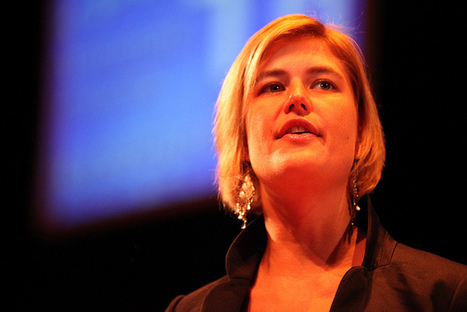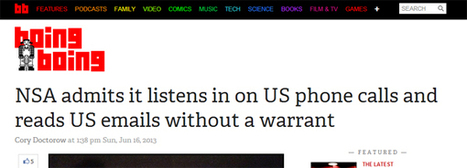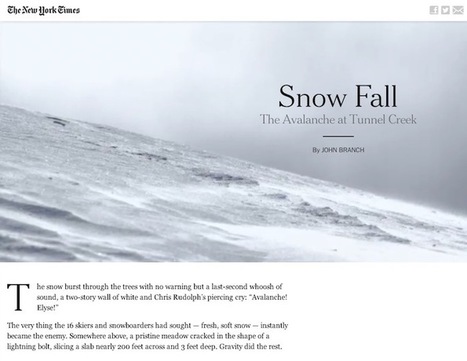 Your new post is loading...
 Your new post is loading...
...Turns out that what we have now are a lot of ethics codes and policies, but very little accountability.To make sense of this, here’s the kind of lapse I’m talking about, none of which seems to have been addressed.
1. NBC selectively edited a video and badly misrepresented a guy in a real ugly case. Not clear if they’ve come clean about it yet.Suggestion: News outlets should make the full recording available, perhaps via a discreet rapid-response accountability team. 2. Sometimes a news outlet might broadcast a public figure lying, even when they know it’s a lie. This is what Jon Stewart calls the “CNN leaves it there” problem.Suggestion: Reporters are smart — if they know they’re being lied to, don’t broadcast it. If they smell a lie but they’re not sure, do a good faith fact-check....
...as a group we tend to be arrogant, self-righteous and holier-than-thou (I include myself in this criticism). We tend to view ourselves as high priests of an exclusive profession and bearers of a special ethical standard that few others can live up to. We see ourselves as purer, more objective, less affected by the prejudices of the mere mortals we cover.
That is at least part of the reason we have trouble in the new world of entrepreneurial journalism, where journalists start and run their own news operations. If we want to go out on our own, we have to recognize for the first time that journalism is a business, that someone has to pay the bills and that there is money involved. Money? This is a dirty word for journalists. It makes us blush. We associate it with influence peddling, lobbyists, bribery, corruption and other topics of our investigative journalism.
Here are some other dirty words that entrepreneurial journalists who launch their own media will have to learn how to say without blushing...
Handheld devices such as mobile phones and tablets are on track to become the dominant platforms for news consumption, and more people are using more than one device, a survey of media consumption habits in nine countries has found.
“News is becoming more mobile, more social, and more real-time,” according to the recently released Reuters Institute Digital News Report 2013: “Tracking the Future of News,” an annual survey which monitors the transition to digital media. “The overwhelming message is that audiences increasingly expect news that they can access anytime, anywhere."
While the survey found the computer remains the primary device for accessing digital news, a third of respondents reported getting news on at least two devices, and 9 percent said they use more than three. Tablet usage doubled in the 10 months since the last survey....
...Up to 15 seconds of video, 13 custom filters, and a "cinema mode" for stabilization. Those were some of the features added to Instagram last week, instantly turning the popular photo-sharing app used by 130 million people into a video-sharing service. Within the first 24 hours of the announcement, over 5 million videos had been uploaded.Sure, some were of frothy lattes and the Miami Heat winning the NBA finals, but the new features have wider appeal than to just casual users.
As newsrooms are now relying on social media as a platform to discover and deliver the news, Instagram's new video features will add another piece of content into the mix for organizations: short, solid-looking video clips.Beth Bennett, assistant professor at The Medill School of Journalism, Media, Integrated Marketing Communications at Northwestern University, believes this will be the next big thing for news organizations....
There were 2,600 less full-time professional editorial jobs at newspapers in 2012, a 6.4% drop from 2011, according to The American Society of News Editors’ latest annual newsroom census figures.
Pew Research has more: “That leaves the industry at 38,000 full-time professional editorial employees and is the first time that figure has been below 40,000 since the census began in 1978. The losses are also more than twice the level estimated in March by Rick Edmonds, coauthor of the chapter on newspapers in the Pew Research Center’s State of the News Media report.”
Traditional journalists probably won't like a lot of how Upworthy's become one of the fastest growing aggregators on the web. But it's hard to question the effectiveness of its methods.
Back in November, the Lab’s own Adrienne LaFrance wrote a number of words about Upworthy, a social packaging and not-quite-news site that has become remarkably successful at making “meaningful content” go viral. She delved into their obsession with testing headlines, their commitment to things that matter, their aggressive pushes across social media, and their commitment to finding stories with emotional resonance.
Things have continued to go well for Upworthy — they’re up to 10 million monthly uniques from 7.5. At the Personal Democracy Forum in New York, editorial director Sara Critchfield shared what she sees as Upworthy’s secret sauce for shareability, namely, seeking out content that generates a significant emotional response from both the reader and the writer....
It happened with the Washington Post‘s initial PRISM story, it happened with Glenn Greenwald’s story in which he wrote that the NSA has “direct access” to servers owned by the various tech giants and, over the weekend, it happened in spectacular fashion with a bombshell article posted on CNET by chief political correspondent Declan McCullagh.The headline that dispersed through social media and political blogs like the swine flu: “NSA admits listening to U.S. phone calls without warrants.”When I spotted the headline, tweeted by a reporter who I otherwise respect, my first reaction was, “Wow. Okay.”
But as I read the article, the headline became less and less accurate — a trend we’ve witnessed several times recently. In fact, McCullagh’s reporting almost entirely disintegrated under just cursory scrutiny… but not before it went viral.McCullagh reported that during a House Judiciary Committee hearing featuring FBI Director Mueller, Rep. Jerrold Nadler (D-NY) revealed that the NSA, during a previous secret briefing, admitted that thousands of NSA analysts could to listen to phone calls without warrants. That was the thrust of McCullagh’s story. But the quotes were awkwardly truncated, the tic-toc of the story was unclear and there were highly speculative paragraphs that jumped to conclusions not supported by the reporting....
...The starting point to understanding the how mainstream media fails to accurately report the news is the consolidation of media ownership in the United States. In 1983 50 corporations controlled the vast majority of all news media in the U.S. In 2002 that number had decreased to 10 companies (McChesney & Nichols, 2002). By 2004 that number had decreased to only five companies. As Nichols and McChesney state, All in all, these [few] firms control the overwhelming percentage of movies, TV shows, cable systems, cable channels, TV stations, radio stations, books, magazines, newspapers, billboards, music and TV networks that constitute the media culture that occupies one half of the average American’s life.
It is an extraordinary degree of economic and social power located in very few hands (Nichols & McChesney, It's the Media Stupid, 2000, p. 28).Five companies control the bulk of information disseminated to the American public via mainstream media. How can one have a diverse discussion of ideas if a handful of people or, in the case of the media, a handful of corporations controls the information that the public receives via mainstream media? The answer is that one cannot. Corporations have one interest in mind: Profit above all else. Financial gain is their only reason for existence. Informing the public is not the corporate media’s principal function, making money is....
I am often asked what it takes to be a great reporter in the digital era. The essential mission, I say, remains the same: to observe, collect and interpret information. Don’t be a generalist; pick a subject, dig deep into it, bring “passion” to the job. That word evokes the obligatory question about objectivity. My response: journalism has always entailed biases, conscious or not. Next, a great reporter engages one-on-one with news consumers, joins social news streams, learns to be a marketer and plays with the technology. I end with this: understand the business models behind the profession — and start to think like an entrepreneur. FORBES has 1,000 writers learning and practicing all of that. Here are four who are leading the way...
The NYT’s multimedia project Snow Fall was a huge success, attracting big audiences and lots of plaudits. ...Snow Fall (and other such attempts) represent a great opportunity and the future for news organizations like The New York Times, especially as they are right now in a losing battle for attention with upstart competitors that include everyone from BuzzFeed to The Huffington Post. If you are the New York Times management, it is time to take a gamble: spend $25 million on creating 100 Snow Fall-like projects.... And in exchange, it got a few million page views, but I am guessing they also built a nice backend infrastructure to create more such projects. As a result, the next Snow Fall is going to cost less, with most future spending going to the creative: words, photos, other multimedia elements and design. So what will the Times (or someone like them) need to get it done? Simply put, a departure from the incumbent thinking, embracing today’s reality and re-imagining the work flow of a big city newspaper. In other words: Re-imagining its business model to factor in the reality of today’s world and forget the legacy of newsprint.Create a new breed of “producer” who can switch between Excel and content.Create a whole new breed of a journalist — one who has old-school values but also the ability to tell a story that works in many mediums of today.Build an editorial creative machine that works differently from a print-centric editorial group....
Twitter is a frenemy," said Jeff Zucker, CNN's new president, as reported by MediaShift. Jeff Zucker was describing the cable news network's relationship with social media and added, “the network uses, relies on -- and is scared by -- social media.” Twitter had a marquee moment last week, particularly late Friday afternoon and evening, that should scare most television news outlets in the business of reporting breaking news. That’s when Boston Marathon bombing suspect Dzhokhar Tsarnaev was cornered by police, trapped and almost bleeding to death inside a covered boat in a backyard in Watertown, Mass....
“Will anyone with information please come forward”. It’s a refrain we always hear police echo in crime-dramas. People are too afraid to come forward though for lack of trust in the official authorities or fear of gangs. That’s especially in poverty-stricken, gang-ridden areas. You can easily imagine the classic scene: New York cops at a ghetto crime scene with apartment residents hiding behind their curtains. Then again, we are constantly documenting massive amounts of potential evidence each time we post a photo via Instagram, a video via Vine or even a report by sending out an ‘eyewitness tweet.’ How do we filter the valuable truth from the inevitable noise of social media?
...and "the editing process is zero, pretty much."... Great insight into the speed of online publishing.
|
Does this signal the beginning of the end for Forbes as a knowledgeable source of business information? Have they finally "jumped the shark" on their way to the exit? "Jumping the shark" is actually an expression that goes back to the TV sitcom series, Happy Days. It was a show that pictured everything as rosy and happy, with neat little endings that were all nicely tied up in twenty-two minutes. The chief influencers on that show were "The Fonz," who only had to give you a look to let you know you were in trouble, and Mr. Cunningham, who set down the rules of the family.
In the midst of its ten-year run the writers must have gotten tired or were negatively influenced by the Hollywood decision-makers, when they inexplicably decided to have their characters travel to Los Angeles. Well, one thing leads to another and Fonzie ends up responding to an assault on his courage by taking to water skis (wearing his leather jacket of course) and jumping over a shark.
The stunt was so ridiculous and out of character that "jumping the shark" eventually came to be known as the moment when a television show begins a decline that is beyond recovery. While Happy Days bravely soldiered on for a few more years, it was never really the same in the minds of viewers and critics. Since that time the meaning has been broadened to define the moment when a brand or creative effort begins to lose the qualities that initially defined its success. Some still refer to "New Coke" as the moment when the Coca-Cola Company jumped the shark....
When it comes to political scandal, why is the media is so out of step with its audience?
Spitzer and Weiner, with their cohorts around the country, are a slap in the media's face. Scandals, after all, are largely media created. You can hardly have a scandal without the media treating it as scandal — Spitzer's and Weiner's being among the tastiest of recent years.
There's a vested interest here. The media is defending its own work. The easy rehabilitation of the badly behaved refutes, if not the facts, certainly much of the media's damnation.While the media has been the instrument of running the offenders out of office, the public wants them back....
Forget the digital doomsayers, said Jill Abramson. “Long-form narrative is not only alive but dancing to new music.”Other prominent journalists echoed The New York Times managing editor’s optimism about thriving in a Twitter age at Boston University’s annual narrative journalism conference last weekend.Abramson said devices like tablets and iPads give long-form narrative new ways to reach new audiences.
She said her paper focuses on integrated storytelling in series like “A Year At War,” with multimedia “freshening” the story by letting readers “see, feel and almost taste” soldiers’ and families’ experiences.She added that new tools can’t trump journalism basics. Wary of “narrow specialists,” she worries that journalism schools’ new technology training may detract from traditional shoe leather reporting values....
One of the biggest complaints about online advertising is that we’ve exchanged print dollars for digital dimes.
One response has been: Well you better start stacking dimes.
The dollar to dime problem is at the heart of journalisms existential woes. I suspect if money were rolling in like it used to, the question of “who IS a journalist” wouldn’t be so passionately debated.
There is a moment I’ve called “the Screenularity“ - it is the moment when consumers do not make a functional distinction between the screens in their life. One can watch video on their handheld screen, one can make a call on the 40-inch screen in their living room. One is not called a “phone” or the other a “TV.”...
Rebecca Jarvis, business and economics correspondent for CBS News, discusses the current state of journalism, what the future holds, and why companies are scooping up journalists to create rich content for their brands.
The best thinking about journalism’s future benefits from its being in touch with technology’s potential. But it can get in its own way when it simplifies and repudiates the intelligence of journalism’s past.
That is happening, to a degree, in a discussion gaining momentum lately that journalism should now largely move beyond fact gathering and toward synthesis and interpretation.
The NSA story is just the latest case that shows the importance, and the elusiveness, of simply knowing what has really happened.
In a Nieman Journalism Lab post, Jonathan Stray made the case recently for moving beyond facts, or what might be called The Displacement Theory of Journalism. “The Internet has solved the basic distribution of event-based facts in a variety of ways; no one needs a news organization to know what the White House is saying when all press briefings are posted on YouTube. What we do need is someone to tell us what it means.”...
The fictional tale about war correspondents will make you laugh till the person next to you on the subway thinks you have problems. It is also, according to writer Alexander Nazaryan, an all-too-real parody of the glory days of print journalism....In only a few years, a child will ask a parent about newspapers: What was their purpose? What did people do with them, and why?
The parent, a little flummoxed, will explain that, long before biosensitive data aggregators simply uploaded information into the neurons of our frontal cortexes, people actually read the news by holding a piece of paper in front of their noses and scanning columns of text with their eyes. There were many such newspapers, to be read in the morning, over breakfast, and in the evening, over scotch. The newspapers competed with each other by sending actual people out into the actual world to report what had taken place, was going to take place — or, even, was alleged to have taken place but didn't. On days when there was little so-called news to report, the newspapers filled their pages with stories about, say, puppies who could recite Macbeth or people who wore jeggings to work. Also, there were crosswords.
Of course, this fictional parent could give his/her fictional child Evelyn Waugh's Scoop — a fictional 1938 tale of British foreign correspondents reporting on a civil war in the fictional East African country of Ishmaelia. Fictional, yes, but to a journalist like myself, most everything about the novel is too real. Waugh was a master at mixing humor and pathos, as evidenced by his two most ambitious novels: A Handful of Dust and Brideshead Revisited. Scoop, on the other hand, is all laughter, of the sort that will make the person next to you on the subway think you have problems...
BuzzFeed gets free content, users get exposure, we get 11 Engagement Photos That Will Make You Happy You’re Single. ... The department devoted to creating this “old school” content is known as BuzzTeam. Their focus is anything shareable — lists, animals, nostalgia. The kind of content that BuzzFeed’s loyal readers have become hyper-familiar with. Many, in fact, have consumed so many such BuzzFeed posts that they’ve become adept at mimicking both their tone and their viral success. Earlier this month, BuzzFeed’s editors took a step toward giving those faithful followers a little more of the spotlight they crave. Shepherd, along with a staff of four, now run BuzzFeed Community, a content-producing vertical of its very own, complete with featured posts by community members and a leaderboard with the latest on who’s posts are getting the most traffic, likes, comments, and badges. It’s a competitive place, and anyone can join and enter the fray....
When it comes to the traditional media business, there is often a pervasive nostalgia for “the good old days,” when a handful of newspapers and TV networks ruled over the media landscape and profitability was so taken for granted that huge family dynasties with names like Sulzberger and Bancroft were built on that foundation. Many media executives no doubt dream about magically returning to such a time. But what if those days were just an illusion — a kind of accident of history? What would that mean for the future of media? This idea has come up before, but I was reminded of it when I read a Nieman Journalism Lab post about some research being done by Lee Humphreys, looking at the way that communication — and particularly personal communication, through letters and diaries and other pre-digital tools of expression. Although this doesn’t seem to have much to do with how we use ultra-modern services like Twitter or Facebook, there is a lot more to it than you might think....
Study: Just four jobs are worse than being a newspaper reporter Poor job rating for news reporter only part of the story 2013 marks the 25th anniversary of the list. ...And while “newspaper reporter” has dropped down the ranks through the years, Lee said it’s been in the bottom half since the list’s inception. “There are reasons why newspaper reporter is at the bottom,” Lee said. “Some of them are reasons that really haven’t changed in 25 years and some of them are new phenomena.” Lee walked me through reasons old and new...
Marketers plan to spend less on newspapers, consumer magazines, radio, trade magazines and TV; Winners are mobile media, social media and marketing automation.... Perhaps marketers are simply reflecting the interests of the audiences they want to reach. Alan Mutter gathers some statistics that point to ominous demographic trends: Only 6% of people in their 20s and 16% of 40-year-olds regularly read newspapers, compared to 48% of people over 65. Only 29% of the U.S. population regularly read a newspaper in 2012, down from 56% in 1991. Three-quarters of the audience at the typical newspaper is 45 years of age or older. In comparison, over-45s comprise only 40% of the population. Print advertising still generates between 80% and 90% of revenues at the typical major metro daily. Mutter asserts that newspaper publishers will never pull out of their tailspin unless they can create products that appeal to the new generation of digital natives who can’t be bothered to drag around paper, CDs or books. For them, the phone and the tablet are their windows on the world, and that will change industries ranging from news to travel to banking....
“It’s become a verb in our newsroom,” a New York Times graphics producer tells me. “People are now saying, ‘can we snowfall this story?’” Snow Fall: The Avalanche at Tunnel Creek has become a watershed in multimedia journalism. The story by John Branch recently won a Pulitzer prize in feature writing, and as noted by the Pulitzer website it was “a project enhanced by its deft integration of multimedia elements.” As a journalism educator, I’m constantly collecting links to examples of stories that attempt innovate and redefine the narrative form online. For years, story structures online have mostly been a repurposing of legacy formats — TV, radio and print. While we are starting to see the journalism industry leverage digital media in very powerful ways, more often it’s a complementary component to a more traditional story structure. For example, you might see an interactive graphic or map or audio slideshow off to the side of a text story. Then came Snow Fall....
|



 Your new post is loading...
Your new post is loading...


































Craig Newmark looks at media in a fact-free, checking world and suggests a "list " of improvements...